Chapter 23. Exporting Data from FileMaker
In this chapter
The Basic Mechanics of Exporting
Exporting to Fixed-Width Formats
Working with Large Fields and Container Fields
Getting Out What You Put In
Much of this book concentrates on tools for data entry—for getting data into a database system. But that information often needs to be extracted again. Sometimes the extraction takes the form of a report of some kind. At other times, the best choice is simply to export the data into some specific format so that another program can import that data and work with it using different tools than might be available in FileMaker. Reasons for exporting might include the following:
- Perhaps you know someone who is compiling a quarterly report in Excel and needs some numbers from your FileMaker system.
- Perhaps the payroll system needs a list of employee names that you have in FileMaker.
- Perhaps you’ve been storing low-resolution images for an upcoming ad campaign in FileMaker, but you would like to make all the images available on a CD that can be used without FileMaker.
In this chapter we cover various means for getting data out of FileMaker. There are two ways of doing so: exporting and real-time sharing. Exporting is a batch or offline process. Real-time sharing of data is discussed in Chapter 21, “Connecting to External SQL Data Sources.”
![]() For more on saving and sending records as Excel or PDF files, see “Delivering Reports,” p. 342.
For more on saving and sending records as Excel or PDF files, see “Delivering Reports,” p. 342.
![]() Information on real-time sharing of data can be found in Chapter 21, “Connecting to External SQL Data Sources,” p. 603.
Information on real-time sharing of data can be found in Chapter 21, “Connecting to External SQL Data Sources,” p. 603.
![]() Additional information bearing on the topic of FileMaker web publishing can be found in Chapter 25, “Instant Web Publishing,” p. 689; Chapter 26, “Custom Web Publishing with XML/XSLT,” p. 715; and Chapter 27, “Custom Web Publishing with PHP,” p. 749.
Additional information bearing on the topic of FileMaker web publishing can be found in Chapter 25, “Instant Web Publishing,” p. 689; Chapter 26, “Custom Web Publishing with XML/XSLT,” p. 715; and Chapter 27, “Custom Web Publishing with PHP,” p. 749.
The Basic Mechanics of Exporting
The basic principles of exporting data from FileMaker are straightforward. You pick a single table or layout from which to export. (You cannot independently export data from two tables at once, although you can export related fields to any extent you want, a topic discussed in more depth later in this chapter.) You then choose an output file format and file location and pick specific fields from your chosen table for export. Before you export, there are a few extra options you can choose that govern grouping and formatting of the exported data. That’s all there is to it. Let’s look at each step a bit more closely.
Choosing a Source Table
As with much else in FileMaker 9, the starting point for a data export is determined by the user’s context in the current system—specifically by the currently active layout, which in turn is tied (via its table occurrence) to an underlying data table (aka source table). So, the currently active layout controls implicitly which table is the source table for the export.
Choosing an Output File Format
After your context is established, you have to choose File, Export to begin the export process. The next step in that process is to choose an output file format and file destination. FileMaker offers you a choice of 12 export formats, as shown in Figure 23.1. Some of these are plain-text formats, such as tab-delimited text, which could be read in any text editor; others are binary file formats that require more specific software to open, such as FileMaker Pro. This chapter goes into greater detail on available file formats in a later section.
Figure 23.1. FileMaker Pro can export data to various formats.
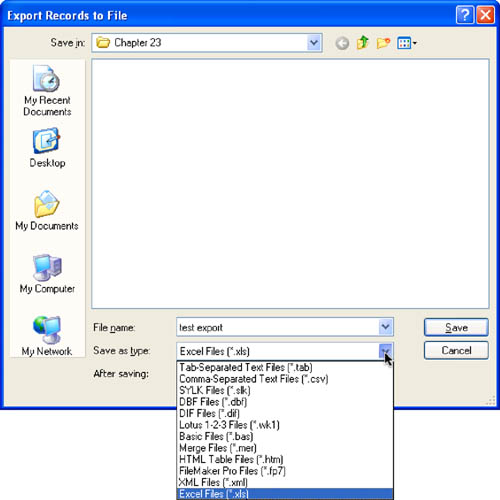
The list of formats obscures two additional features in this dialog: the choice to automatically open the file after saving it and the choice to automatically create an email with the file attached. These choices parallel those available with the Save as Excel and Save as PDF features; the goal in all cases is to make the final delivery of the data faster and easier.
Selecting Fields to Export
After you’ve selected an output file type and destination, you’re prompted to choose some fields to export via the dialog shown in Figure 23.2.
Figure 23.2. Most fields can be exported from a FileMaker database, but container fields cannot.
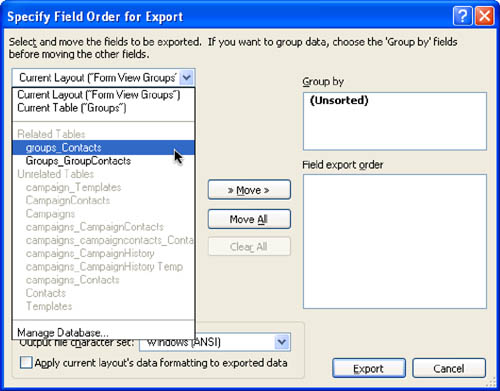
When working with field lists, you often have the ability to limit your consideration to only those fields on the current layout, a feature known as field list filtering. By default, the fields displayed in the list at the left are limited to those found on the current layout, as indicated by the Current Layout menu setting. That is always the first item in the list. It’s possible to switch the view to show all fields in the current or related tables. As in previous versions of FileMaker, it’s also possible to select fields from any related table for export.
![]() For more information on exporting related fields, see “Exporting Related Fields,” p. 656.
For more information on exporting related fields, see “Exporting Related Fields,” p. 656.
In addition to selecting fields for export, it’s also possible to select grouping options for the fields and to choose whether to format the exported data according to the current layout formats. These options, too, are discussed in more detail later in this chapter.
![]() For more information, see “Exporting Grouped Data,” p. 657, and “Formatting Exported Data,” p. 656.
For more information, see “Exporting Grouped Data,” p. 657, and “Formatting Exported Data,” p. 656.
At any point in the field selection process, you can use the small up/down arrows beside each selected field name to change the order in which the fields are exported: Click the arrow and drag to move the field, or use (![]() -up/down) [Ctrl+up/down] if you prefer the keyboard. After you have a satisfactory field list, click Export, and the data will be exported to the file format and location of your choice.
-up/down) [Ctrl+up/down] if you prefer the keyboard. After you have a satisfactory field list, click Export, and the data will be exported to the file format and location of your choice.
Exporting Issues to Consider
Although the basic mechanics of exporting are simple, there are a couple of key points that bear remembering:
- To export data from a file, a user must have sufficient privileges to do so. This is governed by selections within the user’s privilege set. The user must have the Allow Exporting check box checked within the settings for her privilege set. Additionally, the user will not be able to export any records for which she does not have at least the capability to view the record.
 For more information on privileges and security in FileMaker, see Chapter 12, “Implementing Security,” p. 371.
For more information on privileges and security in FileMaker, see Chapter 12, “Implementing Security,” p. 371. - Data will be exported only from records in the user's current found set. To export data from all records in a table, it's first necessary to run Show All Records to ensure that no records are omitted from the found set. Regardless of the found set, any records that the user's privileges prevent her from viewing cannot be exported.
- There are certain practical limits on which fields you can export. Container fields can be exported only if the target file format is a FileMaker Pro file (we discuss other strategies for exporting files in container fields later in the chapter). And there are certain fields, such as summary or global fields, that it might not always make sense to export even though it’s technically possible.
 For more information, see “Working with Large Fields and Container Fields,” p. 659, and “Formatting Exported Data,” p. 656.
For more information, see “Working with Large Fields and Container Fields,” p. 659, and “Formatting Exported Data,” p. 656.
Export File Formats
FileMaker’s Export Records feature can create export files in various formats. Many of these are text-based and a few are binary. In this section, we give an overview of available file types, with some specific notes on each. Each format has its own quirks and limitations. We attempt to call out the main features of each format, but you’ll need to experiment to see just how a specific data set translates to a chosen file format.
Character Transformations
When exporting data, FileMaker often performs substitutions on certain characters that tend to cause confusion when they appear embedded in field contents. For example, FileMaker permits you to embed a tab character in field data, but because the tab character is frequently used as a field separator in text-based data, FileMaker transforms these internal tabs to spaces when exporting. In the same vein, carriage returns within fields sometimes get transformed to the vertical tab character (ASCII code 11). The specific transformations that occur depend on the output file format; see the notes on each format outlined in the following sections for further details.
The transformation of carriage returns to vertical tabs is a significant problem if your data has to be handled as XML along the way because the ASCII 11 character (vertical tab) is not a valid character in XML. When you export data as XML, FileMaker does not make this transformation—it simply eliminates the internal carriage returns. But if you export in a non-XML format, yet need the exported data to be processed via XML at some point, be aware that these embedded vertical tabs will cause the file to be rejected by XML parsers.
One other common transformation occurs when repeating fields are exported (for those formats that support it). Multiple repetitions of a field are often exported with the individual repetition data separated by the group separator character (ASCII code 29). Common transformations are listed in Table 23.1.
Table 23.1. Character Transformation Information for Exporting FileMaker Data
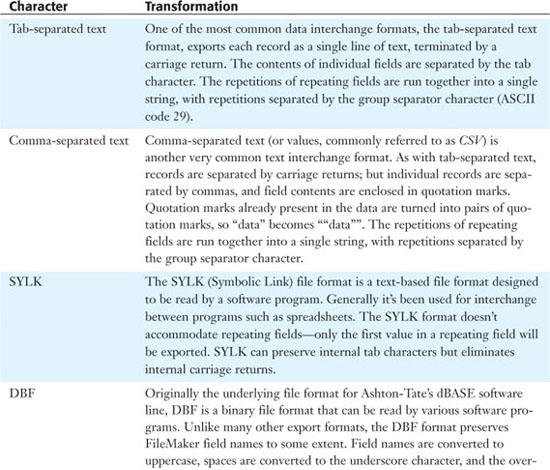
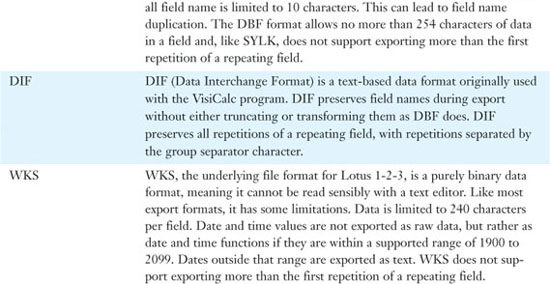

Figure 23.3. You have additional options when using the capability to export to Excel.
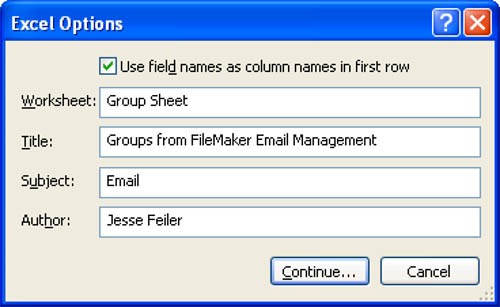
![]() For more information on FileMaker’s XML grammars, see Chapter 25, “FileMaker’s XML Grammars,” p. 664.
For more information on FileMaker’s XML grammars, see Chapter 25, “FileMaker’s XML Grammars,” p. 664.
Formatting Exported Data
FileMaker maintains a distinction between the way data is stored in a field and the way it is displayed. For example, although all dates are stored internally as simple integers, they might be displayed in many different date formats, such as “1-3-2006.” Or a number, stored internally with 17 digits of precision, might be displayed with just 3 or 4 digits. None of these display options has any effect on the data stored in the field—they simply affect the way the data is shown to the user.
On FileMaker layouts, these formatting options are governed by choices made via the Format menu, in Layout mode. Some of these formatting options can be made to carry through to data when it’s exported. To do so, when specifying fields for export, check the box labeled Apply Current Layout’s Formatting to Exported Data. When this choice is selected, any formatting options applied via the Number, Date, or Time formatting dialogs are preserved. Text formatting, even character-based formatting such as uppercasing, is not preserved. Date and time formatting may both be applied to a timestamp field and will be carried through on export.
Not all export types support formatting data based on the current layout. The DBF and DIF file formats offer no support for additional formatting. The WKS format allows additional formatting for time and number fields, but not for date fields.
Exporting Related Fields
All exporting in FileMaker takes place from the context of a single table. In general, then, it’s not possible to export data from several tables independently in one stroke. It is possible, though, to export data from tables related to the current one, whether immediately or more distantly.
Doing so is a simple matter of choosing fields from related tables when specifying fields for export. If the related fields are in the layout you are using, they will be shown in the Specify Field Order dialog as shown previously in Figure 23.2. There, Group Description and Group Name are in the current table, whereas FullName is in groups_Contacts and Contact ID is in Groups_GroupContacts (all of these tables are part of the sample Email Campaign Management starter solution).
When there are related records in a one-to-many relationship, you will get all the existing child records. The main record’s value will appear in the first record as shown in Figure 23.4.
Figure 23.4. You can export fields from child tables, in which case you might get records with partial data.

If you want to export complete records, you can temporarily denormalize the relationship using the old trick that was required before FileMaker 7. In the related table (groups_Contacts in this case), create a calculation that brings the Group Name value down into that table. The calculation will reside in the groups_Contacts table and will be equal to the value in the main (related table). If you export from the groups_Contacts table, you will have complete records to be exported.
Exporting Grouped Data
A typical export outputs some data from each record in the current found set (or, as discussed in the section “Exporting Related Fields,” you might sometimes get multiple sets of information per current record if you export related fields). But what if you don’t want data for each and every record? What if you want to export only data that summarizes information from the current record set, such as you might see in a subsummary report? FileMaker makes this possible as well.
To output summary data, it’s necessary to have one or more summary fields defined.
![]() For more information on summary fields and summary reporting, see “Working with Field Types,” p. 95, and “Summarized Reports,” p. 329.
For more information on summary fields and summary reporting, see “Working with Field Types,” p. 95, and “Summarized Reports,” p. 329.
It now remains to use this summary field in an export. The process is similar to that required for preparing a subsummary report for display. First, isolate the transactions to be summarized (for example, to summarize across all transactions, you would perform Show All Records). Next, sort by the field that would be the break field if you were displaying the data in a subsummary report. You can sort by more than that field. As shown in Figure 23.5, the various sort fields in use at the time you export data are shown; you select the check boxes on any for which you want summarized data.
Figure 23.5. It’s necessary to choose grouping options when exporting summarized data.
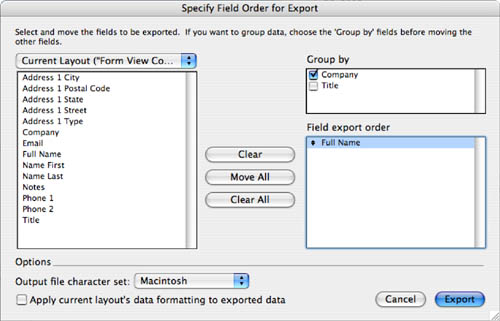
Using more complex sorts and summary field choices, more complex summarized exports are possible.
Exporting to Fixed-Width Formats
Many computer systems exchange data in some form of fixed-width format. This term refers to formats in which an individual field always contains a certain number of characters of data. Data that’s too wide for the field width is sometimes truncated to fit. Data that takes up less space than the field width allows is padded with a padding character, such as a zero or a space, to bring it up to the specified width. For example, the number 797 in a 10-character fixed-width format might be rendered as “0000000797” (left-padded with zeroes). The name Tomczak displayed in a 15-character fixed-width format might be displayed as “Tomczak” (right-padded with spaces). Fixed-width formats also sometimes simply run all the columns together into a single big fixed-width string. There’s no need for internal field separators—because the exact width of each field is known, it’s easy to determine where each field’s data starts and stops.
If you need to export FileMaker data to a fixed-width format, you’ll have to do a bit of work by hand; FileMaker has no built-in support for exporting to a fixed-width format. At a minimum, you’ll need to define some calculations to perform padding and concatenation. If you want to build a more permanent framework for working with fixed-width data, you can consider developing a small library of custom functions to do some of the work.
Padding data is a straightforward activity using FileMaker calculations. Say you have a number field called OrderTotal. To left-pad this number with zeroes and enforce a fixed width of 10 characters, you would use the following calculation:
Right( "0000000000" & OrderTotal; 10)
If you think about that for a moment, it should be clear how it works. The calculation tacks 10 zeroes onto the left of the numeric value, and then takes the rightmost 10 characters of the result. Likewise, to right-pad a text field called FirstName with spaces to a width of 10 characters, the calculation would look like this:
Left( FirstName & " "; 10)
Finally, if you needed to run a set of these fields together into a single fixed-width row, a calculation that concatenated all the individual padding calculations together using the & operator would suffice. You could also create a single row-level calculation without bothering with individual calculations for each field:
Right( "0000000000" & OrderTotal; 10) & Left( FirstName & " "; 10)
Calculations such as these are fine for simple or occasional fixed-width exports. FileMaker also ships with an XSL style sheet, called fixed_width.xsl, which can be applied to a FileMaker data set on export to produce a fixed-width export. The style sheet supports only a single fixed width for all output columns. For more complex needs, you can build a tool of some sort to streamline the process.
Working with Large Fields and Container Fields
Most of the formats discussed so far are predominantly text-oriented; that is, either they treat exported data as text, or at the very least they describe its attributes using text-based formats. But FileMaker has extensive capabilities for handling binary data as well, via the container field type. FileMaker can import files in batches, as discussed in the preceding chapter. FileMaker also has tools that allow you to create a batch export of binary files as well. The key to most such exporting operations is the Export Field Contents command, found in the Edit menu. You can manually enter a single field on a FileMaker layout and choose Edit, Export Field Contents, and the contents of that one field is exported to a file of the appropriate type: a text file for most field types or the actual file contents of a container field. (For example, exporting from a container field containing a file called hurricanes.dbf produces exactly the hurricanes.dbf file.) The Export Field Contents option is not available for a container field unless the field contains something—either an embedded file or a reference to a file.
![]() For more information on the batch import of images, see “Importing Multiple Files from a Folder,” p. 638.
For more information on the batch import of images, see “Importing Multiple Files from a Folder,” p. 638.
When used via the menu, Export Field Contents exports the contents of one selected field from one record. To create something like a batch export of images, it’s necessary to write a script that uses the Export Field Contents script step. Scripted exports are a powerful technique that’s covered in the next section.
Scripted Exports
All the techniques covered so far involve manual export operations, in which the user drives the process by hand, including the selection of output file type and filename, and the selection of fields for export. Exporting, though, is often an operation you want to be able to perform repeatedly, on demand. You might have to export a membership list to a text file periodically, or create a file containing information on this month’s invoices to send to an accounting system that doesn’t interact with FileMaker. In such circumstances, it’s typical that you’ll want to export the same set of fields, for different data sets at different times. In these cases, it makes sense to consider using a script to perform the export.
All aspects of exporting can be scripted, from the selection of the records to be exported, to the determination of output file type, filename, and location, to the choices of specific fields and export options. Consider the script shown in Figure 23.6.
Figure 23.6. Exporting can be fully automated by using a script.

This is a common export script. It goes to a specific layout, it might find certain records, and it sorts them if necessary. In the Export script step, you can select what is exported and where it is to be placed. Users are commonly allowed to select the destination, but you specify the output fields and groups, if any.
When using the Export Records script step, you can choose whether to display any dialogs to the user during the export process. Unless you plan for your user to interact with the export options in some way, such as tweaking the list of fields or field order, you might well want to check this box so that the export “just happens.” The Export Field Contents script step can also be used, especially when exporting container fields. The available export options are similar to those for the Export Records script step. The chief difference is that because Export Field Contents exports data from only one field and record at a time, it would have to be invoked from within a looping script of some sort to export data from all records in the current found set.
